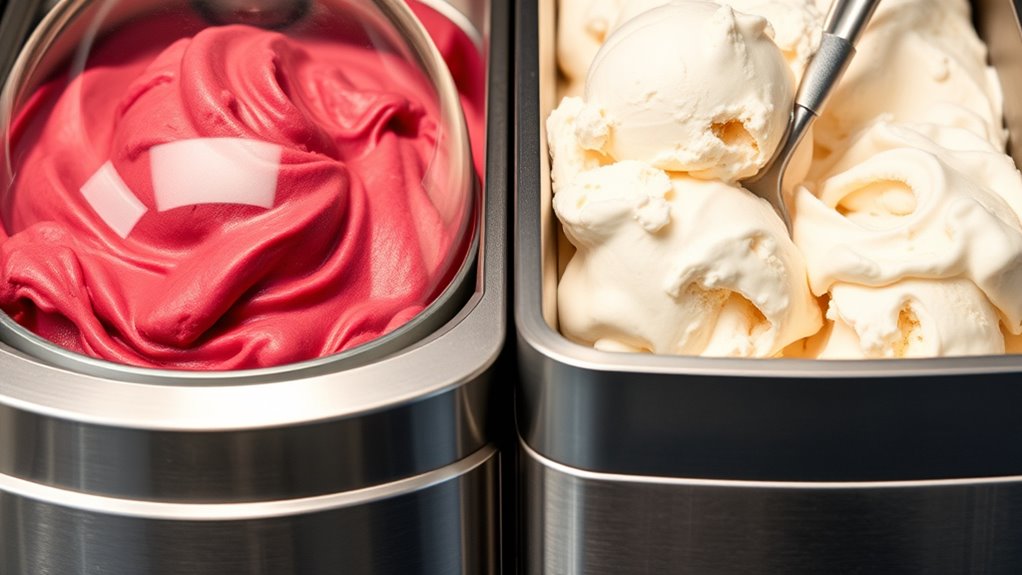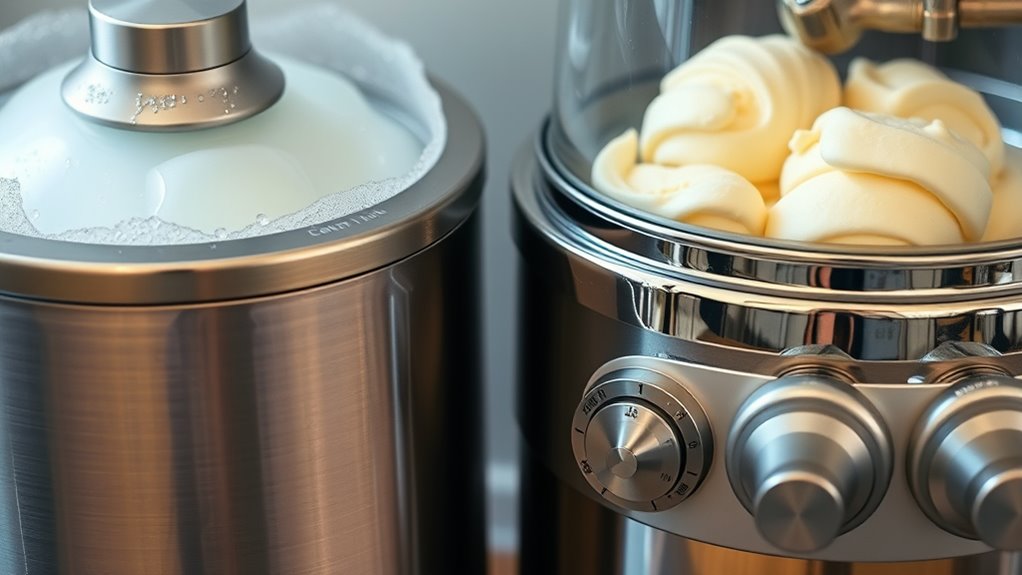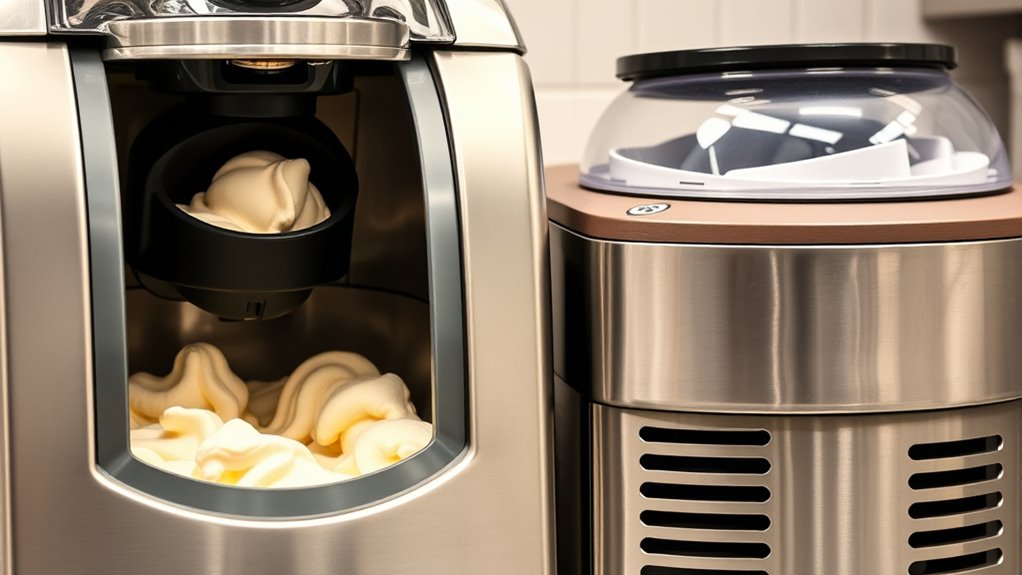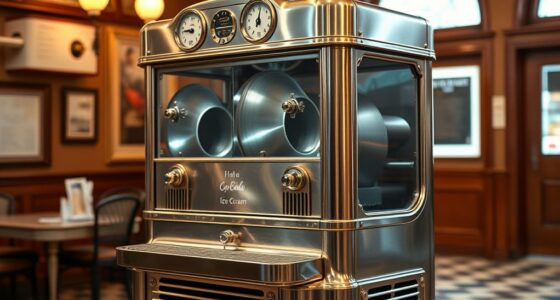Gelato and ice cream machines differ mainly in churning speed, temperature, and ingredients. Gelato machines churn slowly at higher temps, creating dense, soft textures with less air, while ice cream machines churn faster at colder temps, producing lighter, firmer results filled with air. These differences influence flavor intensity, creaminess, and batch size. Want to discover how these variations affect your frozen treats? Keep exploring for all the details.
Key Takeaways
- Gelato machines churn at slower speeds with gentler paddles, producing denser, creamier textures, unlike faster-churning ice cream machines that incorporate more air.
- Gelato contains less fat and air, resulting in a silkier, more intense flavor, whereas ice cream’s higher fat content creates a richer, heavier taste.
- Gelato is frozen at slightly higher temperatures (-4°F to -10°F), yielding softer, more flavorful products, while ice cream freezes colder (-10°F to -20°F) for a firmer texture.
- Batch sizes and freezing times differ, with gelato producing smaller, denser batches slowly, and ice cream offering larger batches with quicker freezing cycles.
- Maintenance and material choices influence durability and cleanliness, with gelato machines often using stainless steel components suited for softer, dense desserts.
How Gelato and Ice Cream Differ in Composition and Texture

Gelato and ice cream differ greatly in their composition and texture, which affects how they feel and taste when you enjoy them. With gelato, the flavor infusion is more intense because it contains less air and a higher proportion of milk and sugar, creating a denser, creamier texture. Ingredient differentiation plays a key role here, as gelato uses more milk and fewer eggs, resulting in a softer, silkier mouthfeel. Additionally, the air content in gelato is generally lower, which enhances the overall richness and flavor concentration. This lower air incorporation allows the flavors to be more pronounced on the palate. Ice cream, on the other hand, often includes egg yolks and more cream, giving it a richer, heavier texture. The lower fat content in gelato allows the flavors to stand out more sharply, providing a more immediate taste experience. This fundamental difference in composition influences both how each treat feels on your palate and how vibrant their flavors seem. Furthermore, texture variation between gelato and ice cream can influence the overall sensory experience, making each suitable for different preferences. Additionally, the calibration of flavor and texture in commercial production ensures consistency and enhances the overall sensory experience of each frozen dessert. The unique ingredient profiles of each frozen treat also contribute to their distinct characteristics and appeal.
The Role of Churning Speed and Agitation in Frozen Dessert Quality

The speed and intensity of churning play a crucial role in determining the texture and quality of frozen desserts. Faster churning creates smaller ice crystals, resulting in a smoother, creamier consistency, while slower speeds can lead to a grainier texture. Agitation also helps evenly distribute ingredients, enhancing flavor infusion throughout the mixture. For gelato, slower churning allows for better flavor development and a denser texture, whereas ice cream benefits from quicker churning to incorporate air and increase volume. Additionally, the churning process influences storage capacity; a properly churned dessert maintains its quality longer, reducing ice crystallization over time. Proper tuning of the churning process ensures optimal performance and consistency of your frozen treats. Controlling churning speed and agitation not only affects the immediate texture but also impacts the long-term stability of the final product, helping it stay fresh and maintain its ideal consistency during storage. Incorporating textured fabrics or natural elements into your kitchen environment can also create a more inviting space for preparing and enjoying these frozen treats.
Temperature Control and Its Impact on Final Results

Your ability to precisely control the temperature directly affects the texture and consistency of your frozen dessert. Adjusting the freezing rate can lead to a smoother, creamier result or a denser, more traditional gelato. Small changes in temperature make a big difference in achieving the perfect final product. Proper storage conditions are essential to maintain optimal texture and prevent spoilage, especially since temperature regulation is key to ensuring quality. Using filter replacement indicators can help monitor when maintenance is needed to keep the machine functioning effectively. Additionally, understanding tuning techniques in vehicle modifications can help optimize equipment performance, much like fine-tuning temperature settings for ideal dessert texture. Using precise temperature control methods can significantly improve the overall quality of your frozen treat.
Precise Temperature Adjustments
Precise temperature adjustments are essential because even slight changes can considerably affect the texture and consistency of your frozen treats. When you control the temperature accurately, you enhance flavor infusion, allowing ingredients to meld better and deliver richer taste. It also helps preserve the desired texture, whether you prefer a smooth gelato or a firmer ice cream. Additionally, maintaining the right temperature optimizes storage capacity, preventing overfreezing or melting issues that could compromise batch size or quality. With precise control, you can fine-tune your machine’s settings to suit specific recipes, ensuring consistent results every time. This level of temperature adjustment ultimately gives you better command over your frozen dessert’s final outcome, making your homemade treats as perfect as possible. For those using specialized equipment, such as a Vetted Flat Iron Bike, precise temperature management can also enhance your overall experience by ensuring optimal performance during extended use. Moreover, precise temperature control is increasingly important as more consumers seek out sustainable and energy-efficient appliances, which often feature advanced temperature regulation systems.
Freezing Rate Influence
Since the rate at which a mixture freezes directly impacts the texture and quality of your frozen dessert, controlling the freezing rate is essential. A faster freeze produces smaller ice crystals, preserving the smoothness of your frozen dessert flavors. Conversely, a slower freeze can lead to larger ice crystals, resulting in a grainier texture. Your storage temperature also influences this process, affecting how quickly your mixture solidifies. Use the table below to see how different freezing rates and temperatures impact your dessert:
| Freezing Rate | Storage Temperature | Effect on Frozen Dessert Flavors |
|---|---|---|
| Fast | -20°C or lower | Smooth, creamy texture, intense flavors |
| Moderate | -15°C | Slightly coarser, balanced flavors |
| Slow | -10°C or higher | Ice crystal formation, flavor dulling |
Implementing precise temperature control can help optimize freezing rate for the best dessert quality. Additionally, understanding the technology of freezing can further enhance your control over the process, ensuring the preservation of biodiversity in the ingredients used. Proper freezing techniques also help retain the nutritional value of the ingredients, maintaining flavor and health benefits.
Texture and Consistency
Controlling the temperature during freezing is essential for achieving the desired texture and consistency in your frozen desserts. Proper temperature management ensures smooth ingredient blending and effective flavor infusion, preventing ice crystal formation that leads to a gritty or icy texture. When your machine maintains a consistent, ideal temperature, it promotes even freezing, resulting in a creamy, velvety finish. Gelato machines typically operate at slightly higher temperatures, which enhances flavor infusion and creates a dense, smooth texture. Conversely, ice cream machines often freeze at colder temperatures, producing a firmer consistency. By understanding how temperature impacts ingredient blending and crystallization, you can tailor your process to craft desserts with the perfect mouthfeel, whether you prefer the silkiness of gelato or the firmness of traditional ice cream. Regular use can also improve overall indoor air quality, ensuring a healthier environment while you enjoy your frozen treats. Additionally, maintaining optimal temperature settings can help extend the lifespan of your appliance, making your investment more worthwhile. Proper cleaning and maintenance, including the use of effective filtration, can also prevent contamination and ensure consistent results over time. Remember, good temperature control is the key to mastering the art of frozen dessert making and achieving professional-quality textures at home.
Differences in Freezing Time and Batch Size Requirements

While gelato and ice cream machines both freeze their mixtures, they differ considerably in freezing time and batch size requirements. Gelato machines typically have longer freezing times because they operate at lower temperatures, which allows for a smoother, denser product. Ice cream machines often freeze faster, reducing the overall batch time. Batch size also varies: gelato machines usually produce smaller batches, making them suitable for home use or small-scale production. Ice cream machines can handle larger quantities, ideal for serving multiple people quickly. If you need quick results and larger batches, an ice cream machine is more practical. However, if you prefer a slower freezing process that enhances texture, gelato machines are better suited for your needs.
Mechanical Design Features Specific to Each Type of Machine

You’ll notice that gelato and ice cream machines differ in churning mechanisms, affecting texture and consistency. Freezing temperatures also vary, influencing how quickly each type solidifies. Additionally, the materials used for containers and their design play a key role in maintaining ideal conditions for each treat.
Churning Mechanisms Differences
Gelato and ice cream machines differ markedly in their churning mechanisms, which directly impact texture and production process. You’ll notice that gelato machines often use slow-moving mixing paddles, gently folding ingredients to maintain a smooth, dense consistency. Ice cream machines typically have faster, more vigorous mixing paddles that incorporate air for a lighter texture. Additionally, compressor types vary: gelato machines often feature continuous run compressors, while ice cream machines may use batch compressors that cycle on and off. Here’s what sets them apart:
- Mixing paddle speed and design
- Paddle movement and agitation style
- Compressor operation cycle
- Overall churning duration
These differences shape the final product’s creaminess and density.
Freezing Temperatures Variance
The mechanical design of gelato and ice cream machines considerably influences their ability to reach and maintain ideal freezing temperatures. This variance impacts shelf life and flavor preservation. Gelato machines typically operate at slightly higher temperatures, around -4°F to -10°F, ensuring a softer texture and better flavor retention. Ice cream machines often reach colder temperatures, between -10°F to -20°F, creating a firmer product with a longer shelf life. The table below highlights these differences:
| Feature | Gelato Machines | Ice Cream Machines |
|---|---|---|
| Operating Temperature | -4°F to -10°F | -10°F to -20°F |
| Temperature Stability | Moderate | High |
| Impact on Shelf Life | Shorter | Longer |
| Flavor Preservation | Superior due to controlled heat | Good, but less ideal |
These design differences directly influence the final product’s quality and longevity.
Container and Material Use
The choice of container and materials plays a crucial role in how gelato and ice cream machines perform and impact the quality of their products. Your selection affects storage capacity, ease of cleaning procedures, and durability. Consider these points:
- Material Type: Stainless steel is common for durability and hygienic cleaning, while plastic may reduce costs but can stain or retain odors.
- Container Design: Gelato machines often have removable, smaller containers for quick cleaning, whereas ice cream machines may feature larger, integrated containers.
- Insulation: Proper insulation in containers maintains consistent temperatures, affecting product quality and freezing efficiency.
- Maintenance: Choose materials that withstand frequent cleaning procedures without corrosion or damage, ensuring longevity and maximum performance.
How to Choose the Right Machine Based on Your Dessert Preferences

Choosing the right machine depends largely on your preferred desserts, as gelato and ice cream each have unique textures and flavor profiles. If you love rich, creamy ice cream with a smooth, aerated texture, opt for a machine with higher storage capacity and powerful churning. For those who enjoy intense flavor infusion and a denser, silkier consistency, a gelato maker is ideal, often offering slower churning speeds that preserve delicate flavors. Consider how much dessert you plan to make regularly; larger capacity machines suit frequent, family-sized batches. Keep in mind that flavor infusion is easier with gelato machines, allowing you to blend ingredients directly into the mix. Your choice should align with your dessert preferences, balancing texture, flavor complexity, and batch size.
Maintenance and Operating Considerations for Gelato and Ice Cream Makers

Maintaining gelato and ice cream machines guarantees they perform at their best and last longer, so understanding their specific cleaning and upkeep needs is essential. Proper cleaning protocols prevent bacteria buildup and ensure quality. Additionally, monitoring power consumption helps optimize efficiency and reduce costs. To keep your machine in top shape, consider these steps:
- Regularly clean all parts using manufacturer-recommended solutions to prevent residue buildup.
- Schedule deep cleans after every few uses to maintain hygiene.
- Check electrical components for wear and ensure proper insulation to control power use.
- Keep the compressor and motor well-maintained to avoid excess power consumption and mechanical failures.
Following these maintenance tips ensures your machine functions smoothly and produces consistent, high-quality desserts.
Frequently Asked Questions
Can I Make Vegan or Dairy-Free Ice Cream With These Machines?
Yes, you can make vegan or dairy-free ice cream with these machines. They handle dairy-free alternatives like almond milk, coconut milk, or cashew cream easily. Just blend your chosen vegan options with sweeteners and flavors, then pour into the machine. It’s a great way to create personalized vegan options at home, giving you full control over ingredients and ensuring a delicious, dairy-free treat every time.
How Do Ambient Temperature and Humidity Affect Machine Performance?
Ambient temperature and humidity levels considerably impact your machine’s performance. Higher temperatures can cause the ingredients to warm up faster, making it harder to keep the mixture cold enough for proper churning. Humidity can lead to condensation, affecting the texture and possibly causing ice buildup. To get the most suitable results, operate your machine in a cool, dry environment, and monitor these conditions to maintain ideal freezing and mixing.
Are There Specific Cleaning Protocols for Gelato Versus Ice Cream Machines?
Think of cleaning your machines as giving them a fresh start each day. You should follow specific sanitation standards and cleaning frequency for gelato and ice cream machines because their ingredients and textures differ. Gelato machines often need more careful, frequent cleaning to prevent flavor transfer, while ice cream machines require thorough sanitation to maintain consistency. Proper protocols keep your equipment running smoothly and your products tasting perfect.
What’S the Typical Lifespan of Each Type of Machine With Regular Use?
You might wonder about the typical lifespan of these machines with regular use. Proper machine maintenance and adhering to storage requirements are key. Gelato machines tend to last around 5-8 years, while ice cream machines can last 7-10 years. Regular cleaning, proper lubrication, and storing them in a dry, cool place help prolong their durability. Consistent care ensures you get the most out of your investment.
Can These Machines Be Used for Making Other Frozen Desserts Like Sorbet or Frozen Yogurt?
You might think these machines are only for ice cream or gelato, but they’re actually quite versatile. Many models can handle alternative dessert options like sorbet or frozen yogurt, thanks to adjustable settings or different bowls. This machine versatility lets you experiment with flavors and textures, making it perfect for creating a variety of frozen treats. So, yes, your machine can definitely help you explore a range of delicious, frozen dessert options.
Conclusion
Choosing between gelato and ice cream machines depends on your taste and production needs. Did you know that gelato typically contains less fat and air, resulting in a denser texture? This means you get a richer, creamier dessert with less churn time. Whichever machine you pick, maintaining it properly guarantees consistent quality. With the right equipment, you can craft your favorite frozen treats perfectly—delighting friends and family with every batch.









